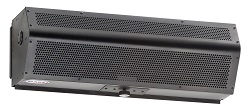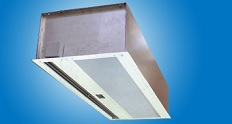 NATIONAL REPORT—Air curtains, also known as air doors, can play an important role in a hotel’s energy conservation strategy—especially hotels with foodservice operations. In use for almost a century now, air curtains have become more sophisticated and effective in recent years and the number of applications for them has grown. Air curtains can now be used in entryways—both in the front and back of the house—with walk-in coolers, warewashers, and even in laundry areas. Air curtains help to contain heated or air conditioned air, and are essential in stopping the infiltration of flying insects, dust and dirt.
NATIONAL REPORT—Air curtains, also known as air doors, can play an important role in a hotel’s energy conservation strategy—especially hotels with foodservice operations. In use for almost a century now, air curtains have become more sophisticated and effective in recent years and the number of applications for them has grown. Air curtains can now be used in entryways—both in the front and back of the house—with walk-in coolers, warewashers, and even in laundry areas. Air curtains help to contain heated or air conditioned air, and are essential in stopping the infiltration of flying insects, dust and dirt.
Air curtains employ a controlled stream of air aimed across an opening to create an air seal. This seal separates different environments, while allowing a smooth, unhindered flow of traffic and unobstructed vision through the opening.
“Air curtains blow an air stream in an engineered pattern to the floor,” says Stephen J. Benes, sales manager with Berner International, which has been making air curtains in the United States since 1956. “Eighty percent of the flow is to keep conditioned air in the building and the other 20 percent pushes it to the ground and to the outside.”
“Air curtains primarily are used at the receiving door where food product is brought in and out,” says Steve Rosol, CEO of Mars Air Systems, a Gardena, Calif.-based company that celebrated its 50th year in business in 2012. “Their primary [purpose] is health food safety—to keep insects out of the kitchen.”
Air curtains are available with heat options. “It takes the edge off of the in-rush of air and tempers it,” Rosol says.
A Vestibule Alternative
Over walk-in coolers/freezers, air curtains provide a more hygienic alternative to plastic strips and in hotel entrances research has shown they can be more cost- and energy-efficient than vestibules. A study funded by Berner International, “Air Curtains: A Proven Alternative to Vestibule Design,” proved that air curtains outperform vestibules in energy savings by 10 percent. Eliminating vestibules saves construction costs. According to Berner, an estimated vestibule cost can be in the tens of thousands of dollars while an air curtain for a single six-foot-wide entrance/exit opening plus installation labor costs less than $6,000.
The addition of air curtains in the International Green Construction Code helps high performance green building advocates push through design criteria such as substituting a vestibule with an air curtain.
To help architects who want to use air curtains in entrance areas, but who don’t want to see them, air curtain makers such as Berner International and Mars Air Systems have introduced units that are in-ceiling mounted and flush with the ceiling.
“Through a redesign we introduced a unit that can be installed in entries up to 16 feet in height,” Berner International’s Benes says.
Mars Air Systems, as part of its Phantom series, offers numerous in-ceiling, flush-mounted options to fit with doors ranging from 42 inches wide to 144 inches. Phantom air curtains can be installed in entries up to 12 feet in height.
Size Not Always an Asset
 “Bigger is not better when it comes to air curtains,” Berner International’s Benes says. “Every manufacturer recommends air curtains at door heights.”
“Bigger is not better when it comes to air curtains,” Berner International’s Benes says. “Every manufacturer recommends air curtains at door heights.”
“More air is not always better,” adds Mars Air Systems’ Rosol.
The Air Movement and Control Association International, Inc. (AMCA) tests and accredits air curtains for airflow, pressure, power and efficiency. An air curtain with AMCA certified performance assures that a manufacturer hasn’t overstated performance specifications. Other accreditations to consider include Electrical Testing Laboratory (ETL) and those established by the National Sanitation Foundation (NSF). Codes or regulations related to air curtains, while primarily in California, can be found elsewhere in the United States as well.
Both Berner International and Mars Air Systems feature calculators on their websites to help one understand the energy savings and return on investment one can achieve with air curtains.
Air curtains do require maintenance. “You want to make sure air pressure is checked and the lubrication is maintained,” Mars Air Systems’ Rosol says. “The intake screen or filter should be clean. The discharge veins should not be broken or closed. Do a visual inspection. Listen for unusual noise. Two times a year do a visual inspection and clean annually.”
When asked what to consider when deciding on a vendor, Rosol added, “Look at who you are doing business with. How long has the company been in business? How much pre-sale support is in place? Who cares if you have a need after the installation?”
Part of LEED Certification Process
Air curtains can help projects earn LEED certification. Air curtains were one of several energy conserving technologies that helped Chicago’s McCormick Place West convention center achieve two of its LEED points from the U.S. Green Building Council in the “Optimized Energy Performance” category.
Glenn Hasek can be reached at editor@greenlodgingnews.com.







